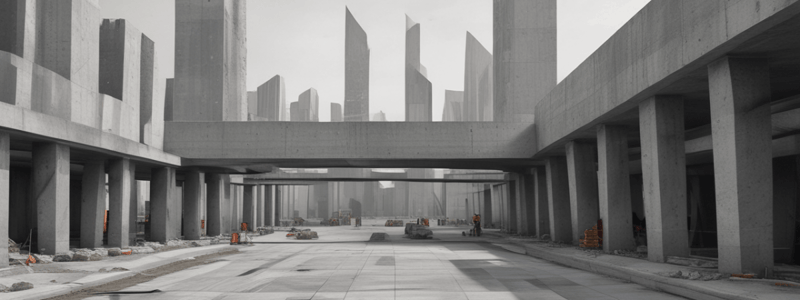Podcast
Questions and Answers
What is concrete?
What is concrete?
- A type of gravel used in construction.
- A type of cement used in concrete.
- A manmade building material that looks like stone. (correct)
- A manmade material that resembles wood.
What does the word 'concrete' come from?
What does the word 'concrete' come from?
- Latin word for stone.
- Latin word for 'to grow together'. (correct)
- Latin word for 'building'.
- Latin word for 'strong'.
What are the components of concrete?
What are the components of concrete?
- Aggregates, sand, and gravel.
- Aggregates, usually sand, and either gravel or crushed stone, held together by a binder of cementitious paste. (correct)
- Aggregates, cement, and supplementary cementing material.
- Aggregates, cement, and water.
What is the estimated annual consumption of concrete worldwide?
What is the estimated annual consumption of concrete worldwide?
Why is concrete widely used?
Why is concrete widely used?
What is one advantage of concrete?
What is one advantage of concrete?
What is another advantage of concrete?
What is another advantage of concrete?
What is another benefit of concrete?
What is another benefit of concrete?
How does the production of concrete compare to steel?
How does the production of concrete compare to steel?
What is the ratio of concrete production to steel production by volume?
What is the ratio of concrete production to steel production by volume?
What is the typical range of cement content in mass concrete?
What is the typical range of cement content in mass concrete?
What is the main influence of maximum aggregate size on concrete?
What is the main influence of maximum aggregate size on concrete?
What is aggregate grading related to?
What is aggregate grading related to?
What is affected by the aggregate shape and texture?
What is affected by the aggregate shape and texture?
What is affected by the aggregate/cement ratio?
What is affected by the aggregate/cement ratio?
What are admixtures in concrete technology?
What are admixtures in concrete technology?
What do mixing procedures in concrete refer to?
What do mixing procedures in concrete refer to?
What is curing in the context of concrete?
What is curing in the context of concrete?
What is the typical range of cement content in normal strength concrete?
What is the typical range of cement content in normal strength concrete?
What is the typical range of cement content in high strength concrete?
What is the typical range of cement content in high strength concrete?
What is an advantage of concrete compared to steel?
What is an advantage of concrete compared to steel?
What is a characteristic of concrete related to its coefficient of thermal expansion?
What is a characteristic of concrete related to its coefficient of thermal expansion?
What is a limitation of concrete?
What is a limitation of concrete?
What is a classification of concrete based on?
What is a classification of concrete based on?
What is a factor that influences concrete properties?
What is a factor that influences concrete properties?
What is a consequence of a lower w/c ratio?
What is a consequence of a lower w/c ratio?
What is a characteristic of concrete in relation to water?
What is a characteristic of concrete in relation to water?
What is a mode of failure of concrete?
What is a mode of failure of concrete?
What is a requirement for fresh concrete?
What is a requirement for fresh concrete?
What is a classification of concrete based on its compressive strength?
What is a classification of concrete based on its compressive strength?
Flashcards
What is concrete?
What is concrete?
A man-made material composed of aggregates (sand, gravel, or crushed stone) bound together by a cementitious paste.
What are the main components of the cementitious paste in concrete?
What are the main components of the cementitious paste in concrete?
Typically made of portland cement, water, and sometimes supplementary cementing materials and chemical admixtures.
What is the w/c ratio?
What is the w/c ratio?
The ratio of water to cement in a concrete mixture.
How does cement content affect concrete?
How does cement content affect concrete?
Signup and view all the flashcards
What are aggregates in concrete?
What are aggregates in concrete?
Signup and view all the flashcards
How does the maximum aggregate size in concrete affect the mix?
How does the maximum aggregate size in concrete affect the mix?
Signup and view all the flashcards
What is the importance of aggregate grading in concrete?
What is the importance of aggregate grading in concrete?
Signup and view all the flashcards
What is the importance of aggregate shape and texture in concrete?
What is the importance of aggregate shape and texture in concrete?
Signup and view all the flashcards
What is the significance of the aggregate/cement ratio in concrete?
What is the significance of the aggregate/cement ratio in concrete?
Signup and view all the flashcards
What are admixtures in concrete?
What are admixtures in concrete?
Signup and view all the flashcards
Why are mixing procedures important in concrete production?
Why are mixing procedures important in concrete production?
Signup and view all the flashcards
What is curing in concrete?
What is curing in concrete?
Signup and view all the flashcards
Why is concrete considered economical?
Why is concrete considered economical?
Signup and view all the flashcards
Why is concrete considered ambient temperature-hardened?
Why is concrete considered ambient temperature-hardened?
Signup and view all the flashcards
What is meant by the ability of concrete to be cast?
What is meant by the ability of concrete to be cast?
Signup and view all the flashcards
Why is using concrete considered energy efficient?
Why is using concrete considered energy efficient?
Signup and view all the flashcards
Why is concrete resistant to water?
Why is concrete resistant to water?
Signup and view all the flashcards
Why is concrete considered high-temperature resistant?
Why is concrete considered high-temperature resistant?
Signup and view all the flashcards
How does concrete incorporate waste?
How does concrete incorporate waste?
Signup and view all the flashcards
Why is concrete compatible with reinforcing steel?
Why is concrete compatible with reinforcing steel?
Signup and view all the flashcards
Why is concrete considered low-maintenance?
Why is concrete considered low-maintenance?
Signup and view all the flashcards
What is meant by the quasi-brittle failure mode of concrete?
What is meant by the quasi-brittle failure mode of concrete?
Signup and view all the flashcards
Why does concrete have low tensile strength?
Why does concrete have low tensile strength?
Signup and view all the flashcards
What is meant by the low toughness (ductility) of concrete?
What is meant by the low toughness (ductility) of concrete?
Signup and view all the flashcards
Why does concrete have low specific strength?
Why does concrete have low specific strength?
Signup and view all the flashcards
What is the need for formwork in concrete construction?
What is the need for formwork in concrete construction?
Signup and view all the flashcards
Why does concrete have a long curing time?
Why does concrete have a long curing time?
Signup and view all the flashcards
What are cracks in concrete?
What are cracks in concrete?
Signup and view all the flashcards
How is concrete classified by unit weight?
How is concrete classified by unit weight?
Signup and view all the flashcards
How is concrete classified based on compressive strength?
How is concrete classified based on compressive strength?
Signup and view all the flashcards
How is concrete classified based on additives?
How is concrete classified based on additives?
Signup and view all the flashcards
Study Notes
Concrete as a Construction Material
- Concrete is a manmade material composed of aggregates (sand, gravel, or crushed stone) held together by a binder of cementitious paste.
- The paste is typically made up of portland cement, water, and may also contain supplementary cementing materials and chemical admixtures.
- Concrete is the most widely used material in the world, with an estimated annual consumption of 11 billion metric tons.
Advantages of Concrete
- Economical: low cost of production compared to other engineered construction materials.
- Ambient temperature-hardened: can gain strength at ambient temperature without high heat.
- Ability to be cast: can be poured into various shapes and sizes on a construction site.
- Energy efficient: low energy consumption during production compared to steel.
- Excellent resistance to water: can be hardened in water and withstand water action.
- High-temperature resistance: conducts heat slowly and can store considerable heat.
- Ability to consume waste: can incorporate waste materials.
- Ability to work with reinforcing steel: similar thermal expansion coefficient to steel.
- Low maintenance required.
Limitations of Concrete
- Quasi-brittle failure mode.
- Low tensile strength: only about 1/10 of its compressive strength for normal-strength concrete.
- Low toughness (ductility).
- Low specific strength (strength/density ratio).
- Formwork is needed to hold its shape and support its weight.
- Long curing time.
- Prone to cracking.
Classification of Concrete
- By unit weight: classified into four categories.
- By compressive strength: classified into four categories.
- By additives: classified based on materials added to the mixture.
Factors Influencing Concrete Properties
- w/c ratio (water-to-cement ratio): affects compressive strength, permeability, and diffusivity.
- Cement content: influences workability, heat release rate, and volume stability.
- Aggregate:
- Maximum aggregate size: affects cement paste requirement.
- Aggregate grading: affects space filling and particle packing.
- Aggregate shape and texture: affects workability, bonding, and compressive strength.
- Aggregate/cement ratio: affects cost, workability, mechanical properties, and volume stability.
- Admixtures: chemical and mineral additives that improve concrete properties.
- Mixing procedures: sequence of putting raw materials into a mixer and mixing time required.
- Curing: measures taken to care for fresh concrete right after casting.
Studying That Suits You
Use AI to generate personalized quizzes and flashcards to suit your learning preferences.
Description
This quiz covers the basics of concrete as a construction material, including its definition and uses. It's designed for 2nd year civil engineering students in the first semester.



